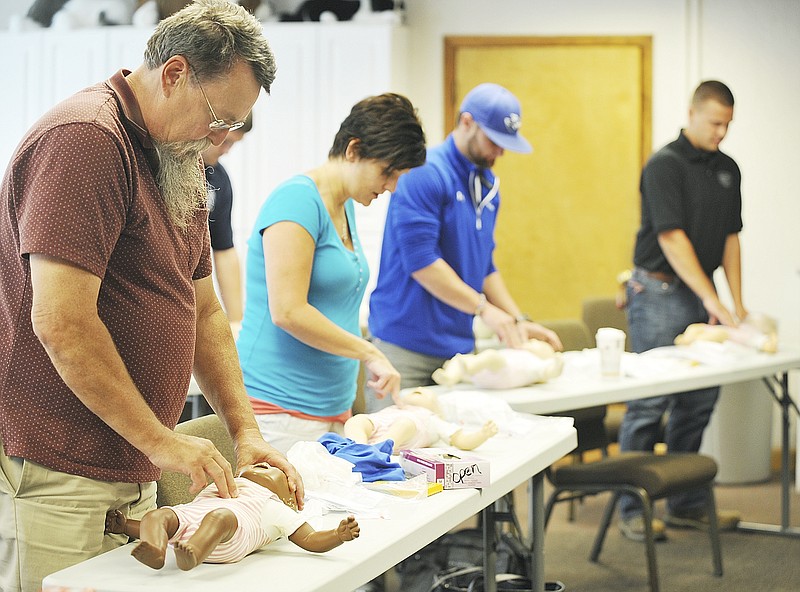Limbless mannequins and infant CPR dummies littered the tables of a small classroom in the Jefferson City chapter of the American Red Cross as students from multiple professions were getting certified to be an instructor for CPR, first aid and automated external defibrillator use on Thursday.
These students were told by video that they would be held to a higher standard, since they will be instructing others on how to execute the techniques taught by the Red Cross. Their instructor, Walker Thomas, provided a bit of comical relief as he was pulling responses from the group.
Thomas has been with the Red Cross for more than 60 years, and he usually teaches or assists with three classes every month, he said. At the two-day instructor course, he not only had to teach his class the proper techniques for CPR and first aid, but also the proper way to teach others the same methods. Two of the teaching tricks he discussed were the sandwich and MARS methods.
He described the sandwich method as anytime an instructor provides criticism to someone they should sandwich it between two compliments. MARS is an acronym for motivation, association, repetition and senses. These four concepts are helpful for adapting a more rounded teaching approach. For instance, a teacher has to motivate their students, and they will learn best by repetition.
"We are learning some good things, some really helpful stuff," said Matt Miller, football coach for the University of Nebraska Kearney. "I have learned some things I have not been taught before."
Most of the attendees for that course were there for their occupations, and one was there because he was a volunteer for the Red Cross. The class had an employee from the State Technical College, a healthy family administrator from Head Start and an employee from the Department of Conservation.
"For me, it is to get NCAA compliance," said Austin Matlock, director of Sports Medicine at Lincoln University. "Pretty much anyone who comes in contact with athletes has to be CPR certified, especially the coaches."
With the training he was receiving, Matlock was going to return to the university as an instructor to help certify the school's coaches and teach a CPR class, he said.
"All of our teachers and staff have to be certified," said Malena Saxbury, the healthy family administrator. "I have not had to use it (CPR). But I have had a parent who has had to use it about two weeks after they learned how to."
The Red Cross certifies instructors once a month, depending on how many people sign up for the course, Thomas said. The organization hosts several more classes for basic CPR and first aid certification throughout the month. The Red Cross has classes scheduled up until Aug. 29 in Jefferson City and Columbia. Other than the fee, there are not a lot of requirements for those who enroll.
"It is a course for anybody from any age," said Maureen Kuchy, health and safety instructors for the CPR courses of the American Red Cross."Even a 12-year-old can take it and learn the ability to give CPR. And we have a gamut of people from various industries and backgrounds."
Kuchy said the most important things the classes teach are how to save a life, to know what to do in a emergency and to not be scared when the situation comes. She has had to use CPR twice in her life and help choking victims at least four times, she said.
"I would say that 97 percent of our enrollees nationwide are required to take it (the course) as a job requirement," said Evie White, logistics specialist for American Red Cross. "One of the goals of the Red Cross is to build resiliency in our communities and CPR training does that. The more people we get trained in these skills the more lives can be saved."

